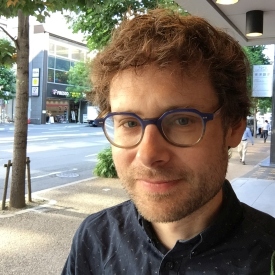Who can tell an authentic story? When I was a funder, it was my job to tell the stories of grantees. Now I am rethinking authenticity in storytelling through a project called Mobile Voices. (Full disclosure: I am currently a researcher studying Mobile Voices at USC Annenberg, and was previously at a foundation that indirectly supported Mobile Voices.)
At one level, Mobile Voices is a storytelling platform for low-wage immigrants in Los Angeles. One of my motivations for participating is that Mobile Voices embodies a philosophy of critical reflection on power across a storytelling chain, with implications for all.
To illustrate the chain’s length, consider a funder (previously me), telling a grantee’s story to justify a grantmaking budget: that story might begin with HASTAC and the Competition, including Cathy Davidson and this website. In turn, Cathy and her team might feature the story of Mobile Voices (a winner of its 2009 DML Competition). Specifically, they could feature one of the researchers/designers on the project, such as USC professor Francois Bar (e.g., see his interesting blog post on translation in Mobile Voices). Francois, in turn, might be telling the story of working with Amanda at IDEPSCA, the nonprofit that organizes low-wage immigrants, and co-designed Mobile Voices. Of course, Amanda would likely be retelling the story of one of the immigrants with whom she works, such as Madelou. Finally, Madelou is using the Mobile Voices tools and her cellphone to tell the story of one of her fellow workers. (That’s five degrees of separation!)
Is it authentic for funders to retell the story of a low-wage worker, across five degrees of separation? Of course not, and I believe that everyone in this chain is working to avoid it — and working to empower low-wage immigrants to speak directly to funding review panels. But that doesn’t happen often.
One reason is that the chain itself constitutes an important story, one that funders tell to describe impact in terms of the relationships between organizations and individuals, of networks and collaborations. But the hierarchy of this chain is also particular. It is a hierarchy of descending public profile, beginning with a major foundation, then HASTAC, followed by a University research group, then the community-based organization, only then the community leader, and at last: a community member(!). It’s no coincidence that fundraising is decided at the top, and needed most by those at the bottom.
This is likewise a hierarchy of storytelling. Those at the top have the resources and the national attention to tell their own story — and they carefully protect and cultivate their “reputational assets.” Those at the bottom don’t just risk being voiceless, they often endure others spreading false stories about them. This is where authenticity is most clearly needed. Madelou once explained her tireless volunteering for Mobile Voices in terms of counteracting the hate that is spread about immigrants (e.g., try a Google search for “day laborer” and behold the vile second listing, with its talk of “some of the most violent murderers, rapists, child molesters…” — oye!!).
If there is beauty in storytelling, it comes from the connection forged between the teller and the listener. And so we must ask, even as low-wage workers reclaim their voice, who is listening? We must challenge foundations to listen not just to their grantees, but to listen across storytelling chains. And we must all struggle to listen for the chain itself, to hear its rattles of differentiated power, both linking communication nodes, and inserting spaces between authentic storytellers. As we make participatory media, Mobile Voices reminds me: we must also strive for more participatory listening.
[This is also cross-posted on HASTAC’s community site.]
